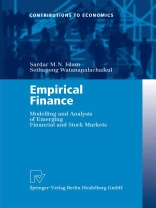This book makes two key contributions to empirical finance. First it provides a comprehensive analysis of the Thai stock market. Second it presents an excellent exposition ofhow modem econometric techniques can be utilised to understand a market. The increasing globalisation of the world’s financial markets has made our un derstanding of the risk-return relationship in a broader range of markets critical. This is particularly so in emerging markets where market depth and liquidity are major issues. One such emerging market is Thailand. The Thai capital market isof particular interest given that it was the market in which the Asian financial crises commenced. As such an understanding ofthe Thai capital market via study of the pre and post-crisis periods enables one to shed light on one of the major financial markets events of recent times. This book provides a quantitative analysis of the Thai capital market using some very useful and recent econometric techniques. The book provides an over view of the Thai stock market in chapter 2. Descriptive statistics and time series models (moving average, exponential smoothing, ARIMA) are presented in chap ter 3 followed by market efficiency tests based on autocorrelations in chapter 4. A richer set of models is then considered in chapters 5 through 8. Chapter 5 finds a cointegrating relationship between macroeconomic factors and stock returns.
Mục lục
1 Introduction.- 2 The Thai Financial System: Characteristics of the Emerging Thai Stock.- 3 Descriptive Statistics and General Characteristics of the Stock Market.- 4 Market Efficiency Models and Tests.- 5 Stock Valuation Models.- 6 Models for Rational Speculative Bubbles.- 7 Models for Anomalies Studies.- 8 Volatility Models.- 9 Summary and Conclusions.- Appendix 1 Structure of Financial Institutions in Thailand.- Appendix 2 Market Efficiency and ARIMA Test Results.- Appendix 3 Regression Test Results.- List of Figures.- List of Tables.- List of Appendices.- About the Authors.












